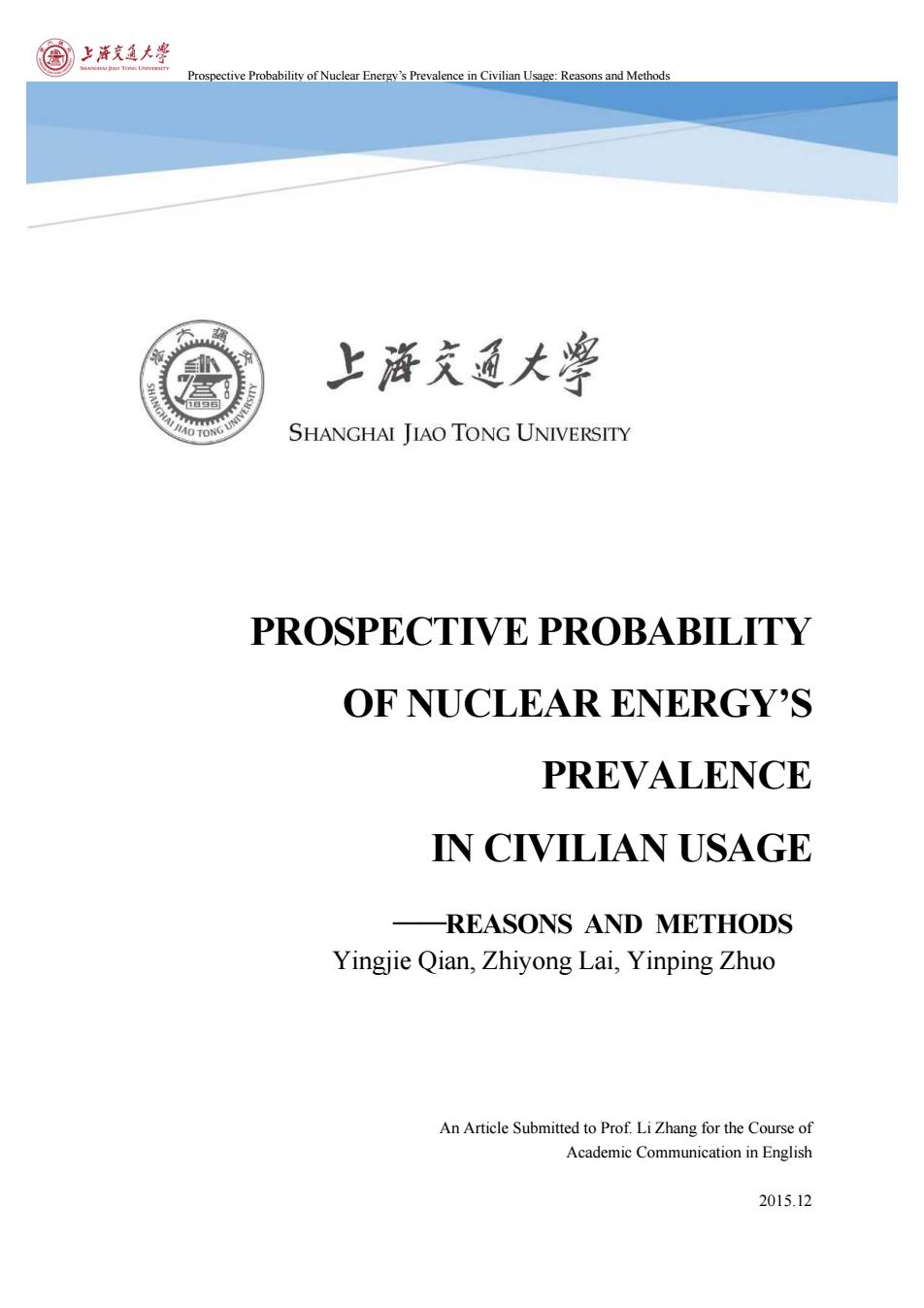
上游充通大粤 Prospective Probability of Nuclear Energy's Prevalence in Civilian Usage:Reasons and Methods 的 上游充通大睾 O TONG SHANGHAI JIAO TONG UNIVERSITY PROSPECTIVE PROBABILITY OF NUCLEAR ENERGY'S PREVALENCE IN CIVILIAN USAGE REASONS AND METHODS Yingjie Qian,Zhiyong Lai,Yinping Zhuo An Article Submitted to Prof.Li Zhang for the Course of Academic Communication in English 2015.12
Prospective Probability of Nuclear Energy’s Prevalence in Civilian Usage: Reasons and Methods PROSPECTIVE PROBABILITY OF NUCLEAR ENERGY’S PREVALENCE IN CIVILIAN USAGE ——REASONS AND METHODS Yingjie Qian, Zhiyong Lai, Yinping Zhuo An Article Submitted to Prof. Li Zhang for the Course of Academic Communication in English 2015.12
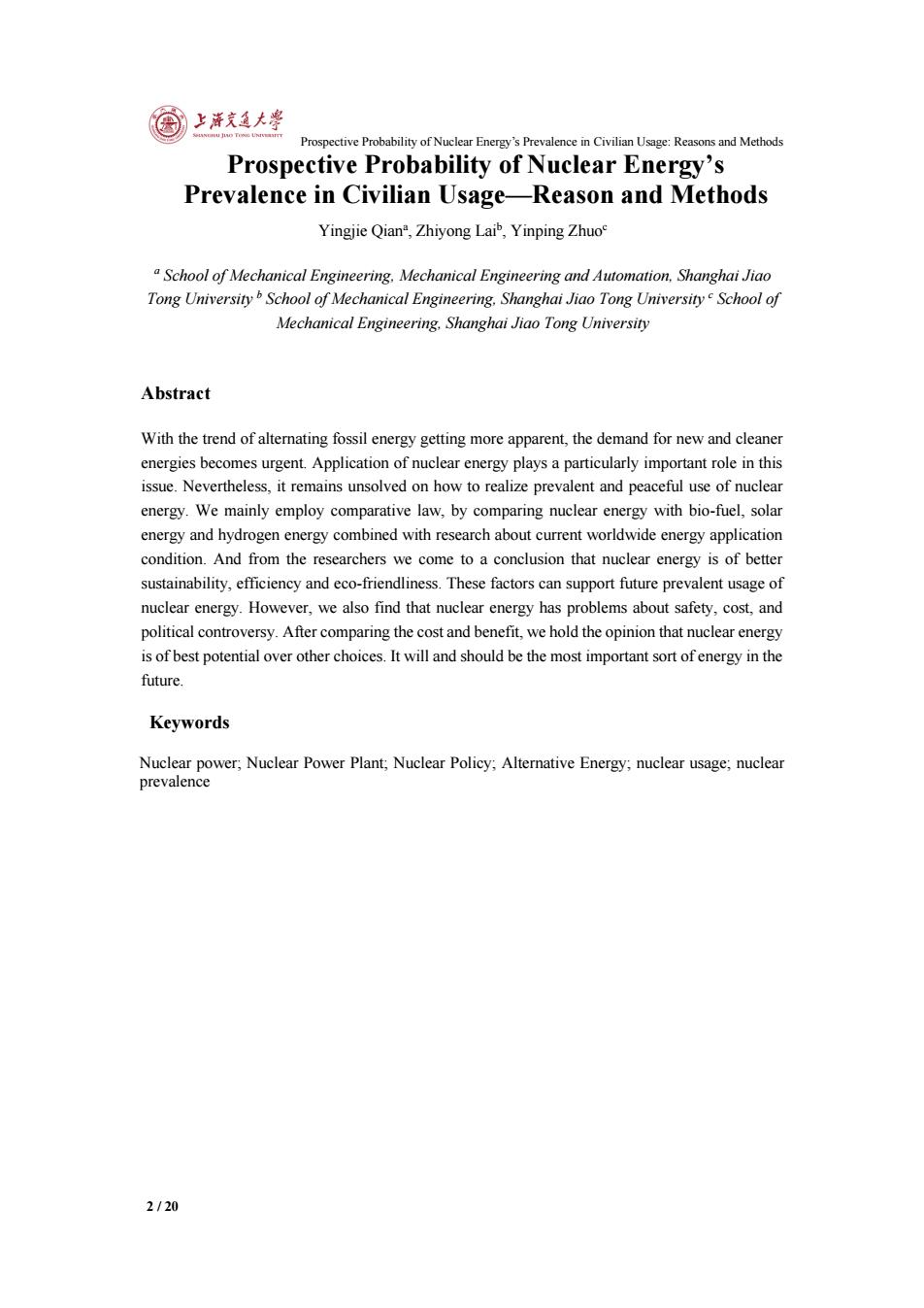
上泽克通大粤 Prospective Probability of Nuclear Energy's Prevalence in Civilian Usage:Reasons and Methods Prospective Probability of Nuclear Energy's Prevalence in Civilian Usage-Reason and Methods Yingjie Qian",Zhiyong Laib,Yinping Zhuo a School of Mechanical Engineering,Mechanical Engineering and Automation.Shanghai Jiao Tong Universityb School of Mechanical Engineering.Shanghai Jiao Tong University School of Mechanical Engineering.Shanghai Jiao Tong University Abstract With the trend of alternating fossil energy getting more apparent,the demand for new and cleaner energies becomes urgent.Application of nuclear energy plays a particularly important role in this issue.Nevertheless,it remains unsolved on how to realize prevalent and peaceful use of nuclear energy.We mainly employ comparative law,by comparing nuclear energy with bio-fuel,solar energy and hydrogen energy combined with research about current worldwide energy application condition.And from the researchers we come to a conclusion that nuclear energy is of better sustainability,efficiency and eco-friendliness.These factors can support future prevalent usage of nuclear energy.However,we also find that nuclear energy has problems about safety,cost,and political controversy.After comparing the cost and benefit,we hold the opinion that nuclear energy is of best potential over other choices.It will and should be the most important sort of energy in the future. Keywords Nuclear power;Nuclear Power Plant;Nuclear Policy;Alternative Energy;nuclear usage;nuclear prevalence 2/20
Prospective Probability of Nuclear Energy’s Prevalence in Civilian Usage: Reasons and Methods 2 / 20 Prospective Probability of Nuclear Energy’s Prevalence in Civilian Usage—Reason and Methods Yingjie Qiana , Zhiyong Laib , Yinping Zhuoc a School of Mechanical Engineering, Mechanical Engineering and Automation, Shanghai Jiao Tong University b School of Mechanical Engineering, Shanghai Jiao Tong University c School of Mechanical Engineering, Shanghai Jiao Tong University Abstract With the trend of alternating fossil energy getting more apparent, the demand for new and cleaner energies becomes urgent. Application of nuclear energy plays a particularly important role in this issue. Nevertheless, it remains unsolved on how to realize prevalent and peaceful use of nuclear energy. We mainly employ comparative law, by comparing nuclear energy with bio-fuel, solar energy and hydrogen energy combined with research about current worldwide energy application condition. And from the researchers we come to a conclusion that nuclear energy is of better sustainability, efficiency and eco-friendliness. These factors can support future prevalent usage of nuclear energy. However, we also find that nuclear energy has problems about safety, cost, and political controversy. After comparing the cost and benefit, we hold the opinion that nuclear energy is of best potential over other choices. It will and should be the most important sort of energy in the future. Keywords Nuclear power; Nuclear Power Plant; Nuclear Policy; Alternative Energy; nuclear usage; nuclear prevalence
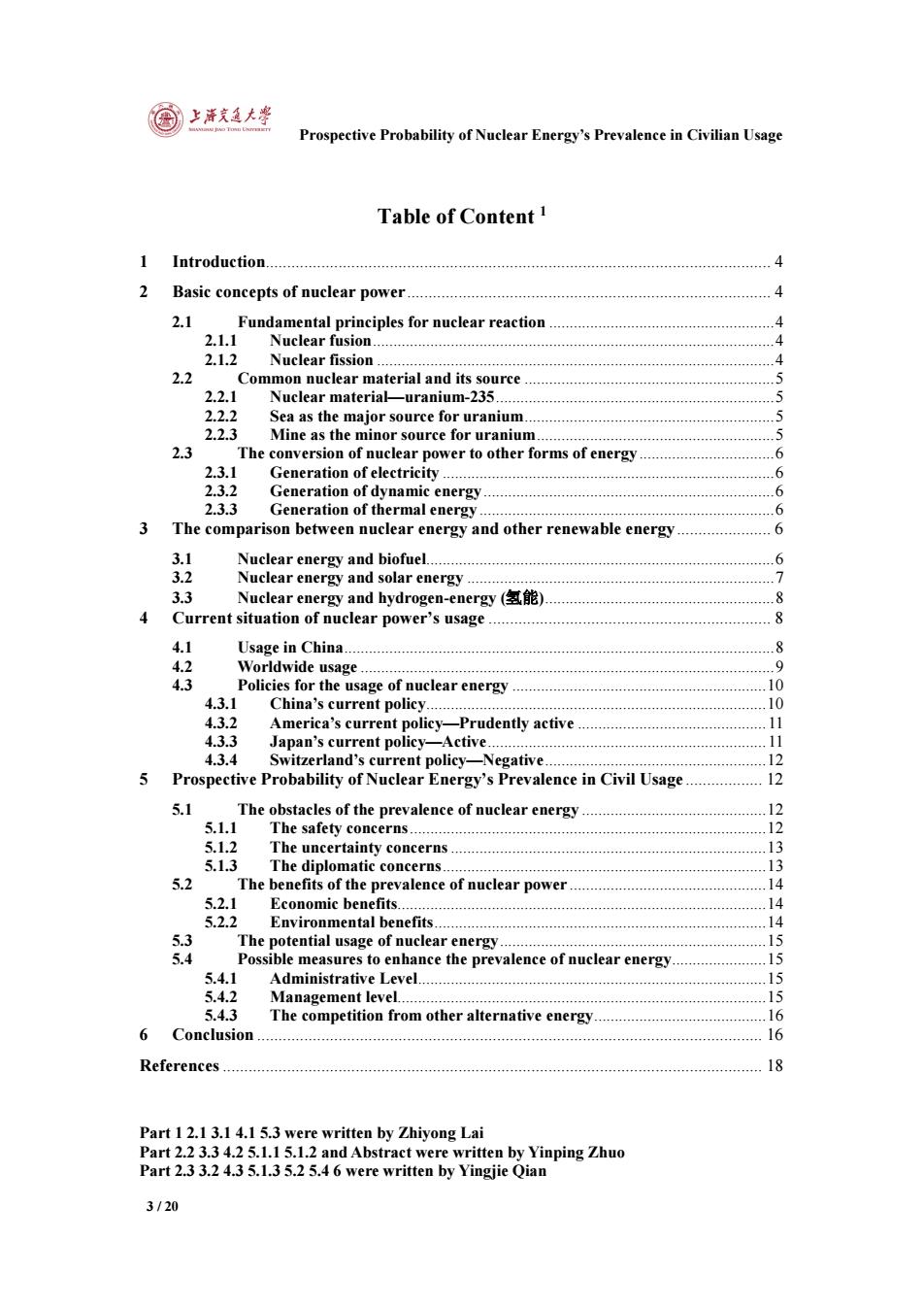
上亥盈大粤 Prospective Probability of Nuclear Energy's Prevalence in Civilian Usage Table of Content 1 2 Basic concepts of nuclear power................ 4 2.1 Fundamental principles for nuclear reaction...4 2.1.1 Nuclear fusion..4 2.1.2 Nuclear fission.......... 4 2.2 Common nuclear material and its source.5 2.2.1 Nuclear material-uranium-235............... .5 2.2.2 Sea as the major source for uranium.5 2.2.3 Mine as the minor source for uranium...... .5 2.3 The conversion of nuclear power to other forms of energy..6 2.3.1 Generation of electricity ........... 6 2.3.2 Generation of dynamic energy6 2.3.3 Generation of thermal energy...... 6 3 The comparison between nuclear energy and other renewable energy......6 3.1 Nuclear energy and biofuel6 3.2 Nuclear energy and solar energy..... 7 3.3 Nuclear energy and hydrogen-energy(氢能) .8 4 Current situation of nuclear power's usage................ .8 4.1 Usage in China.......... .8 4.2 W0rld小wide usage..9 4.3 Policies for the usage of nuclear energy.......... 10 4.3.1 China's current policy.10 4.3.2 America's current policy-Prudently active.......................... 11 4.3.3 Japan's current policy-Active 11 4.3.4 Switzerland's current policy-Negative....... . Prospective Probability of Nuclear Energy's Prevalence in Civil Usage 2 5.1 The obstacles of the prevalence of nuclear energy..12 5.1.1 The safety concerns..12 5.1.2 The uncertainty concerns.13 5.1.3 The diplomatic concerns.... 13 5.2 The benefits of the prevalence of nuclear power............ 1 5.2.1 Economic benefits...... 14 5.2.2 Environmental benefits. 14 5.3 The potential usage of nuclear energy.15 5.4 Possible measures to enhance the prevalence of nuclear energy...........15 5.4.1 Administrative Level..1 5.4.2 Management level............ 15 ””””” 5.4.3 The competition from other alternative energy........................ 16 6 Conclusion 6 References................. 18 Part 1 2.1 3.1 4.1 5.3 were written by Zhiyong Lai Part 2.2 3.3 4.2 5.1.1 5.1.2 and Abstract were written by Yinping Zhuo Part 2.3 3.2 4.3 5.1.3 5.2 5.4 6 were written by Yingjie Qian 3/20
Prospective Probability of Nuclear Energy’s Prevalence in Civilian Usage 3 / 20 Table of Content 1 1 Introduction...................................................................................................................... 4 2 Basic concepts of nuclear power..................................................................................... 4 2.1 Fundamental principles for nuclear reaction .......................................................4 2.1.1 Nuclear fusion..................................................................................................4 2.1.2 Nuclear fission .................................................................................................4 2.2 Common nuclear material and its source .............................................................5 2.2.1 Nuclear material—uranium-235....................................................................5 2.2.2 Sea as the major source for uranium.............................................................5 2.2.3 Mine as the minor source for uranium..........................................................5 2.3 The conversion of nuclear power to other forms of energy.................................6 2.3.1 Generation of electricity .................................................................................6 2.3.2 Generation of dynamic energy.......................................................................6 2.3.3 Generation of thermal energy ........................................................................6 3 The comparison between nuclear energy and other renewable energy...................... 6 3.1 Nuclear energy and biofuel.....................................................................................6 3.2 Nuclear energy and solar energy ...........................................................................7 3.3 Nuclear energy and hydrogen-energy (氢能)........................................................8 4 Current situation of nuclear power’s usage .................................................................. 8 4.1 Usage in China.........................................................................................................8 4.2 Worldwide usage .....................................................................................................9 4.3 Policies for the usage of nuclear energy ..............................................................10 4.3.1 China’s current policy...................................................................................10 4.3.2 America’s current policy—Prudently active ..............................................11 4.3.3 Japan’s current policy—Active....................................................................11 4.3.4 Switzerland’s current policy—Negative......................................................12 5 Prospective Probability of Nuclear Energy’s Prevalence in Civil Usage .................. 12 5.1 The obstacles of the prevalence of nuclear energy .............................................12 5.1.1 The safety concerns.......................................................................................12 5.1.2 The uncertainty concerns.............................................................................13 5.1.3 The diplomatic concerns...............................................................................13 5.2 The benefits of the prevalence of nuclear power ................................................14 5.2.1 Economic benefits..........................................................................................14 5.2.2 Environmental benefits.................................................................................14 5.3 The potential usage of nuclear energy.................................................................15 5.4 Possible measures to enhance the prevalence of nuclear energy.......................15 5.4.1 Administrative Level.....................................................................................15 5.4.2 Management level..........................................................................................15 5.4.3 The competition from other alternative energy..........................................16 6 Conclusion ...................................................................................................................... 16 References.............................................................................................................................. 18 Part 1 2.1 3.1 4.1 5.3 were written by Zhiyong Lai Part 2.2 3.3 4.2 5.1.1 5.1.2 and Abstract were written by Yinping Zhuo Part 2.3 3.2 4.3 5.1.3 5.2 5.4 6 were written by Yingjie Qian
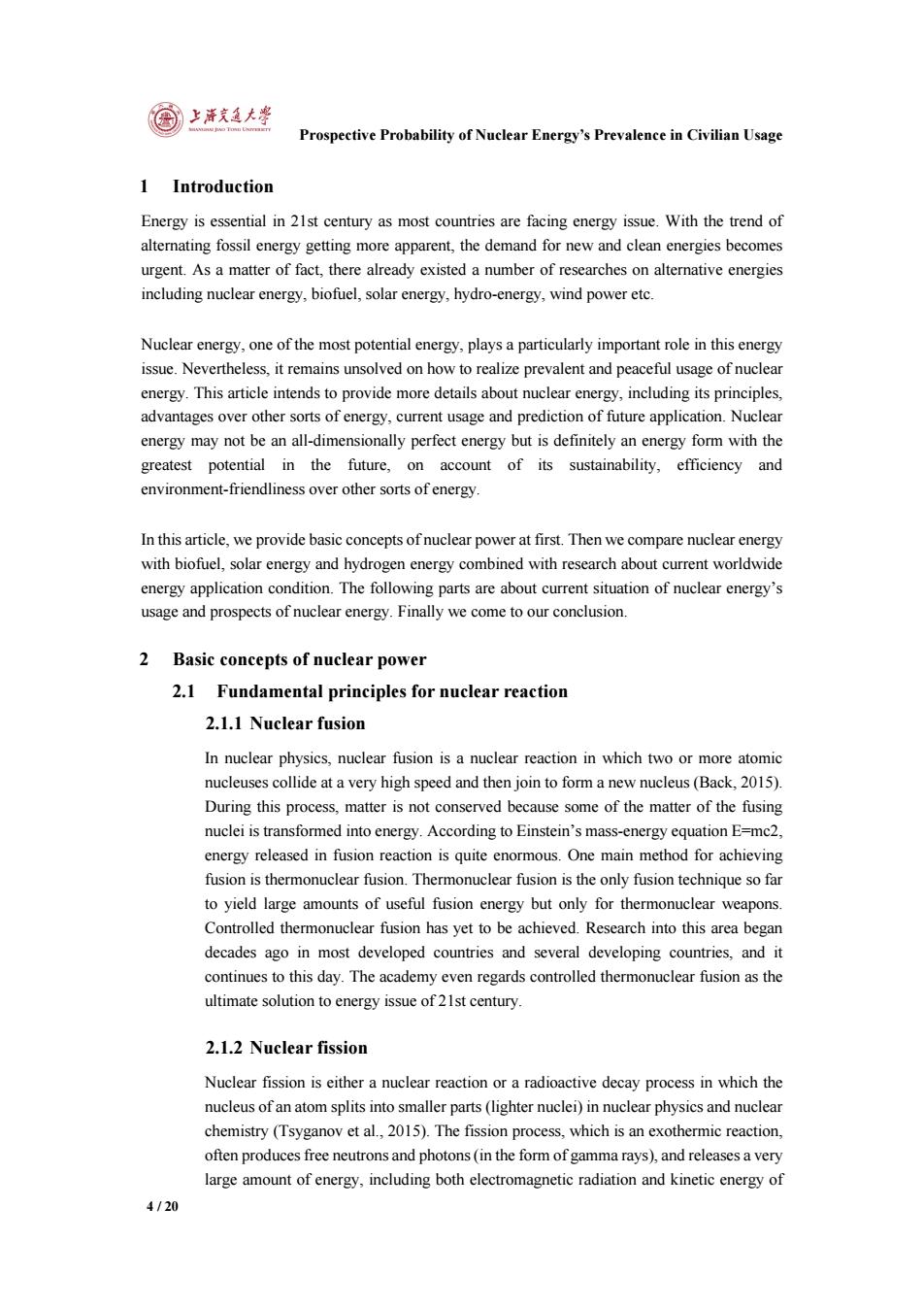
上充益大粤 Prospective Probability of Nuclear Energy's Prevalence in Civilian Usage 1 Introduction Energy is essential in 21st century as most countries are facing energy issue.With the trend of alternating fossil energy getting more apparent,the demand for new and clean energies becomes urgent.As a matter of fact,there already existed a number of researches on alternative energies including nuclear energy,biofuel,solar energy,hydro-energy,wind power etc. Nuclear energy,one of the most potential energy,plays a particularly important role in this energy issue.Nevertheless,it remains unsolved on how to realize prevalent and peaceful usage of nuclear energy.This article intends to provide more details about nuclear energy,including its principles, advantages over other sorts of energy,current usage and prediction of future application.Nuclear energy may not be an all-dimensionally perfect energy but is definitely an energy form with the greatest potential in the future,on account of its sustainability,efficiency and environment-friendliness over other sorts of energy. In this article,we provide basic concepts of nuclear power at first.Then we compare nuclear energy with biofuel,solar energy and hydrogen energy combined with research about current worldwide energy application condition.The following parts are about current situation of nuclear energy's usage and prospects of nuclear energy.Finally we come to our conclusion. 2 Basic concepts of nuclear power 2.1 Fundamental principles for nuclear reaction 2.1.1 Nuclear fusion In nuclear physics,nuclear fusion is a nuclear reaction in which two or more atomic nucleuses collide at a very high speed and then join to form a new nucleus(Back,2015). During this process,matter is not conserved because some of the matter of the fusing nuclei is transformed into energy.According to Einstein's mass-energy equation E=mc2, energy released in fusion reaction is quite enormous.One main method for achieving fusion is thermonuclear fusion.Thermonuclear fusion is the only fusion technique so far to yield large amounts of useful fusion energy but only for thermonuclear weapons. Controlled thermonuclear fusion has yet to be achieved.Research into this area began decades ago in most developed countries and several developing countries,and it continues to this day.The academy even regards controlled thermonuclear fusion as the ultimate solution to energy issue of 21st century. 2.1.2 Nuclear fission Nuclear fission is either a nuclear reaction or a radioactive decay process in which the nucleus of an atom splits into smaller parts (lighter nuclei)in nuclear physics and nuclear chemistry(Tsyganov et al.,2015).The fission process,which is an exothermic reaction, often produces free neutrons and photons(in the form of gamma rays),and releases a very large amount of energy,including both electromagnetic radiation and kinetic energy of 4/20
Prospective Probability of Nuclear Energy’s Prevalence in Civilian Usage 4 / 20 1 Introduction Energy is essential in 21st century as most countries are facing energy issue. With the trend of alternating fossil energy getting more apparent, the demand for new and clean energies becomes urgent. As a matter of fact, there already existed a number of researches on alternative energies including nuclear energy, biofuel, solar energy, hydro-energy, wind power etc. Nuclear energy, one of the most potential energy, plays a particularly important role in this energy issue. Nevertheless, it remains unsolved on how to realize prevalent and peaceful usage of nuclear energy. This article intends to provide more details about nuclear energy, including its principles, advantages over other sorts of energy, current usage and prediction of future application. Nuclear energy may not be an all-dimensionally perfect energy but is definitely an energy form with the greatest potential in the future, on account of its sustainability, efficiency and environment-friendliness over other sorts of energy. In this article, we provide basic concepts of nuclear power at first. Then we compare nuclear energy with biofuel, solar energy and hydrogen energy combined with research about current worldwide energy application condition. The following parts are about current situation of nuclear energy’s usage and prospects of nuclear energy. Finally we come to our conclusion. 2 Basic concepts of nuclear power 2.1 Fundamental principles for nuclear reaction 2.1.1 Nuclear fusion In nuclear physics, nuclear fusion is a nuclear reaction in which two or more atomic nucleuses collide at a very high speed and then join to form a new nucleus (Back, 2015). During this process, matter is not conserved because some of the matter of the fusing nuclei is transformed into energy. According to Einstein’s mass-energy equation E=mc2, energy released in fusion reaction is quite enormous. One main method for achieving fusion is thermonuclear fusion. Thermonuclear fusion is the only fusion technique so far to yield large amounts of useful fusion energy but only for thermonuclear weapons. Controlled thermonuclear fusion has yet to be achieved. Research into this area began decades ago in most developed countries and several developing countries, and it continues to this day. The academy even regards controlled thermonuclear fusion as the ultimate solution to energy issue of 21st century. 2.1.2 Nuclear fission Nuclear fission is either a nuclear reaction or a radioactive decay process in which the nucleus of an atom splits into smaller parts (lighter nuclei) in nuclear physics and nuclear chemistry (Tsyganov et al., 2015). The fission process, which is an exothermic reaction, often produces free neutrons and photons (in the form of gamma rays), and releases a very large amount of energy, including both electromagnetic radiation and kinetic energy of
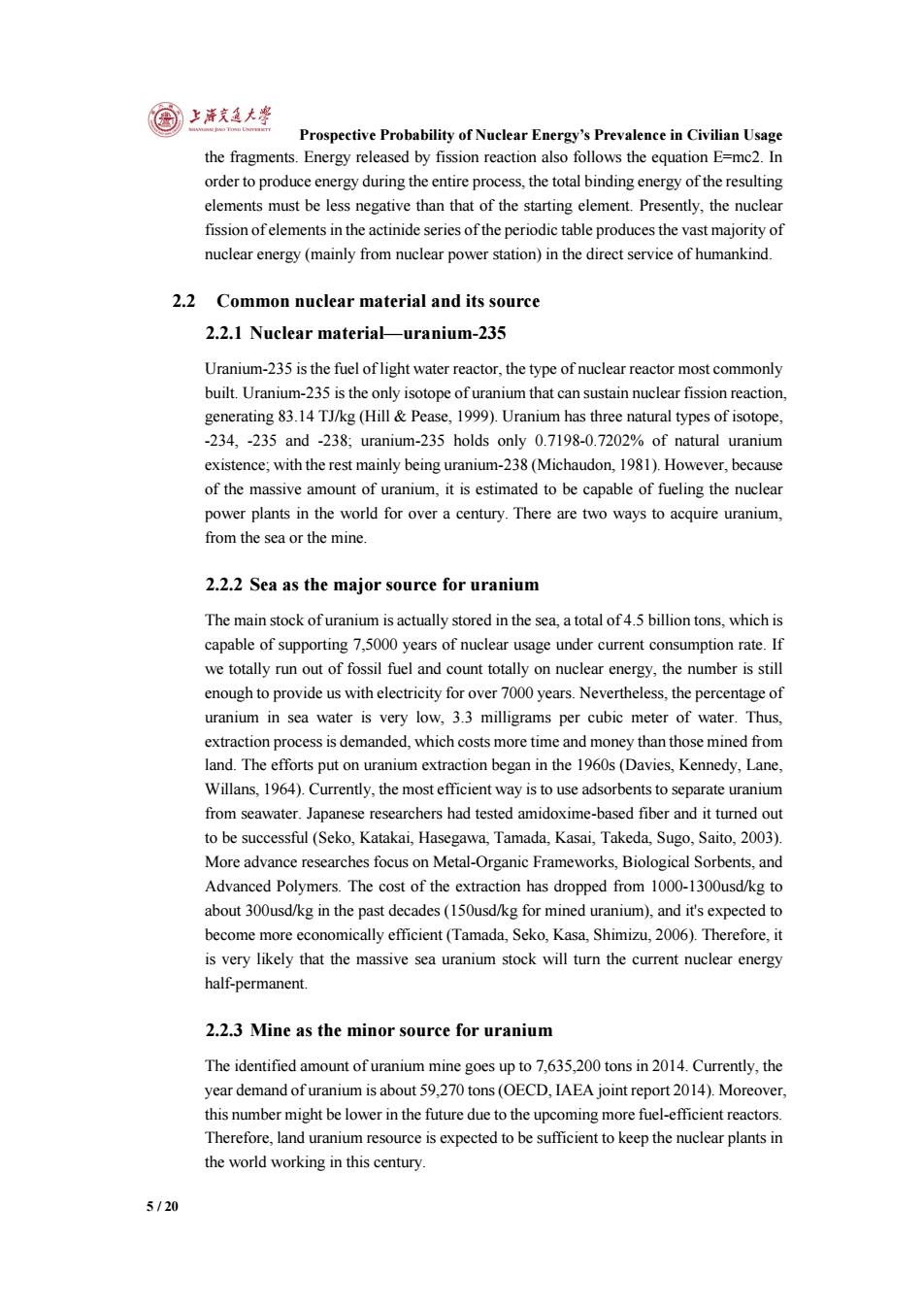
上充益大粤 Prospective Probability of Nuclear Energy's Prevalence in Civilian Usage the fragments.Energy released by fission reaction also follows the equation E=mc2.In order to produce energy during the entire process,the total binding energy of the resulting elements must be less negative than that of the starting element.Presently,the nuclear fission ofelements in the actinide series of the periodic table produces the vast majority of nuclear energy(mainly from nuclear power station)in the direct service of humankind. 2.2 Common nuclear material and its source 2.2.1 Nuclear material-uranium-235 Uranium-235 is the fuel of light water reactor,the type of nuclear reactor most commonly built.Uranium-235 is the only isotope of uranium that can sustain nuclear fission reaction, generating 83.14 TJ/kg (Hill Pease,1999).Uranium has three natural types of isotope, -234,-235 and -238;uranium-235 holds only 0.7198-0.7202%of natural uranium existence;with the rest mainly being uranium-238(Michaudon,1981).However,because of the massive amount of uranium,it is estimated to be capable of fueling the nuclear power plants in the world for over a century.There are two ways to acquire uranium, from the sea or the mine. 2.2.2 Sea as the major source for uranium The main stock of uranium is actually stored in the sea,a total of 4.5 billion tons,which is capable of supporting 7,5000 years of nuclear usage under current consumption rate.If we totally run out of fossil fuel and count totally on nuclear energy,the number is still enough to provide us with electricity for over 7000 years.Nevertheless,the percentage of uranium in sea water is very low,3.3 milligrams per cubic meter of water.Thus, extraction process is demanded,which costs more time and money than those mined from land.The efforts put on uranium extraction began in the 1960s(Davies,Kennedy,Lane, Willans,1964).Currently,the most efficient way is to use adsorbents to separate uranium from seawater.Japanese researchers had tested amidoxime-based fiber and it turned out to be successful(Seko,Katakai,Hasegawa,Tamada,Kasai,Takeda,Sugo,Saito,2003). More advance researches focus on Metal-Organic Frameworks.Biological Sorbents.and Advanced Polymers.The cost of the extraction has dropped from 1000-1300usd/kg to about 300usd/kg in the past decades (150usd/kg for mined uranium).and it's expected to become more economically efficient(Tamada,Seko,Kasa,Shimizu,2006).Therefore,it is very likely that the massive sea uranium stock will turn the current nuclear energy half-permanent. 2.2.3 Mine as the minor source for uranium The identified amount of uranium mine goes up to 7,635,200 tons in 2014.Currently,the year demand of uranium is about 59,270 tons(OECD,IAEA joint report 2014).Moreover, this number might be lower in the future due to the upcoming more fuel-efficient reactors. Therefore,land uranium resource is expected to be sufficient to keep the nuclear plants in the world working in this century. 5/20
Prospective Probability of Nuclear Energy’s Prevalence in Civilian Usage 5 / 20 the fragments. Energy released by fission reaction also follows the equation E=mc2. In order to produce energy during the entire process, the total binding energy of the resulting elements must be less negative than that of the starting element. Presently, the nuclear fission of elements in the actinide series of the periodic table produces the vast majority of nuclear energy (mainly from nuclear power station) in the direct service of humankind. 2.2 Common nuclear material and its source 2.2.1 Nuclear material—uranium-235 Uranium-235 is the fuel of light water reactor, the type of nuclear reactor most commonly built. Uranium-235 is the only isotope of uranium that can sustain nuclear fission reaction, generating 83.14 TJ/kg (Hill & Pease, 1999). Uranium has three natural types of isotope, -234, -235 and -238; uranium-235 holds only 0.7198-0.7202% of natural uranium existence; with the rest mainly being uranium-238 (Michaudon, 1981). However, because of the massive amount of uranium, it is estimated to be capable of fueling the nuclear power plants in the world for over a century. There are two ways to acquire uranium, from the sea or the mine. 2.2.2 Sea as the major source for uranium The main stock of uranium is actually stored in the sea, a total of 4.5 billion tons, which is capable of supporting 7,5000 years of nuclear usage under current consumption rate. If we totally run out of fossil fuel and count totally on nuclear energy, the number is still enough to provide us with electricity for over 7000 years. Nevertheless, the percentage of uranium in sea water is very low, 3.3 milligrams per cubic meter of water. Thus, extraction process is demanded, which costs more time and money than those mined from land. The efforts put on uranium extraction began in the 1960s (Davies, Kennedy, Lane, Willans, 1964). Currently, the most efficient way is to use adsorbents to separate uranium from seawater. Japanese researchers had tested amidoxime-based fiber and it turned out to be successful (Seko, Katakai, Hasegawa, Tamada, Kasai, Takeda, Sugo, Saito, 2003). More advance researches focus on Metal-Organic Frameworks, Biological Sorbents, and Advanced Polymers. The cost of the extraction has dropped from 1000-1300usd/kg to about 300usd/kg in the past decades (150usd/kg for mined uranium), and it's expected to become more economically efficient (Tamada, Seko, Kasa, Shimizu, 2006). Therefore, it is very likely that the massive sea uranium stock will turn the current nuclear energy half-permanent. 2.2.3 Mine as the minor source for uranium The identified amount of uranium mine goes up to 7,635,200 tons in 2014. Currently, the year demand of uranium is about 59,270 tons (OECD, IAEA joint report 2014). Moreover, this number might be lower in the future due to the upcoming more fuel-efficient reactors. Therefore, land uranium resource is expected to be sufficient to keep the nuclear plants in the world working in this century
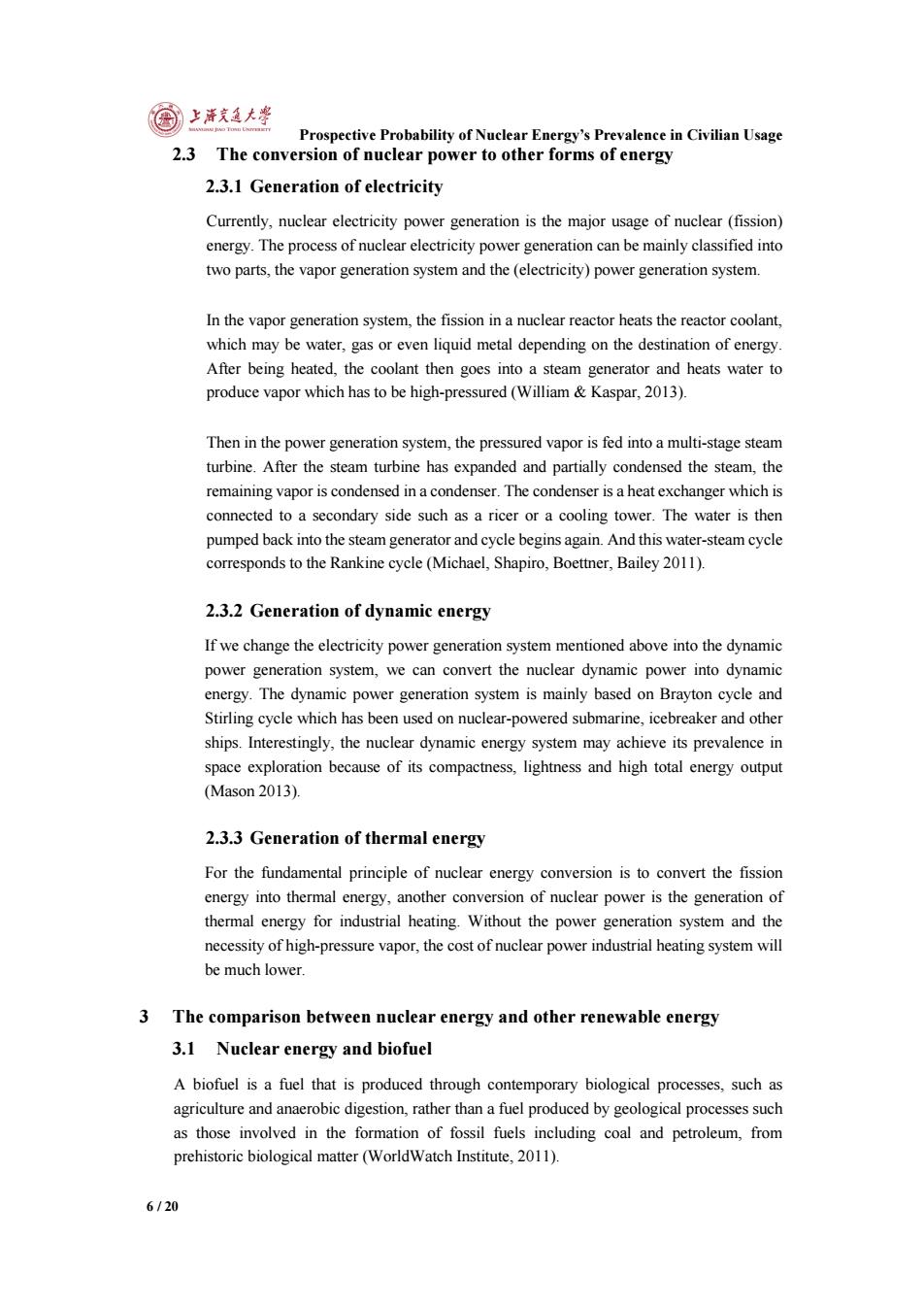
国上道大》 Prospective Probability of Nuclear Energy's Prevalence in Civilian Usage 2.3 The conversion of nuclear power to other forms of energy 2.3.1 Generation of electricity Currently,nuclear electricity power generation is the major usage of nuclear(fission) energy.The process of nuclear electricity power generation can be mainly classified into two parts,the vapor generation system and the(electricity)power generation system. In the vapor generation system,the fission in a nuclear reactor heats the reactor coolant, which may be water,gas or even liquid metal depending on the destination of energy. After being heated,the coolant then goes into a steam generator and heats water to produce vapor which has to be high-pressured (William Kaspar,2013). Then in the power generation system,the pressured vapor is fed into a multi-stage steam turbine.After the steam turbine has expanded and partially condensed the steam,the remaining vapor is condensed in a condenser.The condenser is a heat exchanger which is connected to a secondary side such as a ricer or a cooling tower.The water is then pumped back into the steam generator and cycle begins again.And this water-steam cycle corresponds to the Rankine cycle(Michael,Shapiro,Boettner,Bailey 2011). 2.3.2 Generation of dynamic energy If we change the electricity power generation system mentioned above into the dynamic power generation system,we can convert the nuclear dynamic power into dynamic energy.The dynamic power generation system is mainly based on Brayton cycle and Stirling cycle which has been used on nuclear-powered submarine,icebreaker and other ships.Interestingly,the nuclear dynamic energy system may achieve its prevalence in space exploration because of its compactness,lightness and high total energy output (Mason 2013). 2.3.3 Generation of thermal energy For the fundamental principle of nuclear energy conversion is to convert the fission energy into thermal energy,another conversion of nuclear power is the generation of thermal energy for industrial heating.Without the power generation system and the necessity of high-pressure vapor,the cost of nuclear power industrial heating system will be much lower. 3 The comparison between nuclear energy and other renewable energy 3.1 Nuclear energy and biofuel A biofuel is a fuel that is produced through contemporary biological processes,such as agriculture and anaerobic digestion,rather than a fuel produced by geological processes such as those involved in the formation of fossil fuels including coal and petroleum,from prehistoric biological matter (WorldWatch Institute.2011). 6/20
Prospective Probability of Nuclear Energy’s Prevalence in Civilian Usage 6 / 20 2.3 The conversion of nuclear power to other forms of energy 2.3.1 Generation of electricity Currently, nuclear electricity power generation is the major usage of nuclear (fission) energy. The process of nuclear electricity power generation can be mainly classified into two parts, the vapor generation system and the (electricity) power generation system. In the vapor generation system, the fission in a nuclear reactor heats the reactor coolant, which may be water, gas or even liquid metal depending on the destination of energy. After being heated, the coolant then goes into a steam generator and heats water to produce vapor which has to be high-pressured (William & Kaspar, 2013). Then in the power generation system, the pressured vapor is fed into a multi-stage steam turbine. After the steam turbine has expanded and partially condensed the steam, the remaining vapor is condensed in a condenser. The condenser is a heat exchanger which is connected to a secondary side such as a ricer or a cooling tower. The water is then pumped back into the steam generator and cycle begins again. And this water-steam cycle corresponds to the Rankine cycle (Michael, Shapiro, Boettner, Bailey 2011). 2.3.2 Generation of dynamic energy If we change the electricity power generation system mentioned above into the dynamic power generation system, we can convert the nuclear dynamic power into dynamic energy. The dynamic power generation system is mainly based on Brayton cycle and Stirling cycle which has been used on nuclear-powered submarine, icebreaker and other ships. Interestingly, the nuclear dynamic energy system may achieve its prevalence in space exploration because of its compactness, lightness and high total energy output (Mason 2013). 2.3.3 Generation of thermal energy For the fundamental principle of nuclear energy conversion is to convert the fission energy into thermal energy, another conversion of nuclear power is the generation of thermal energy for industrial heating. Without the power generation system and the necessity of high-pressure vapor, the cost of nuclear power industrial heating system will be much lower. 3 The comparison between nuclear energy and other renewable energy 3.1 Nuclear energy and biofuel A biofuel is a fuel that is produced through contemporary biological processes, such as agriculture and anaerobic digestion, rather than a fuel produced by geological processes such as those involved in the formation of fossil fuels including coal and petroleum, from prehistoric biological matter (WorldWatch Institute, 2011)
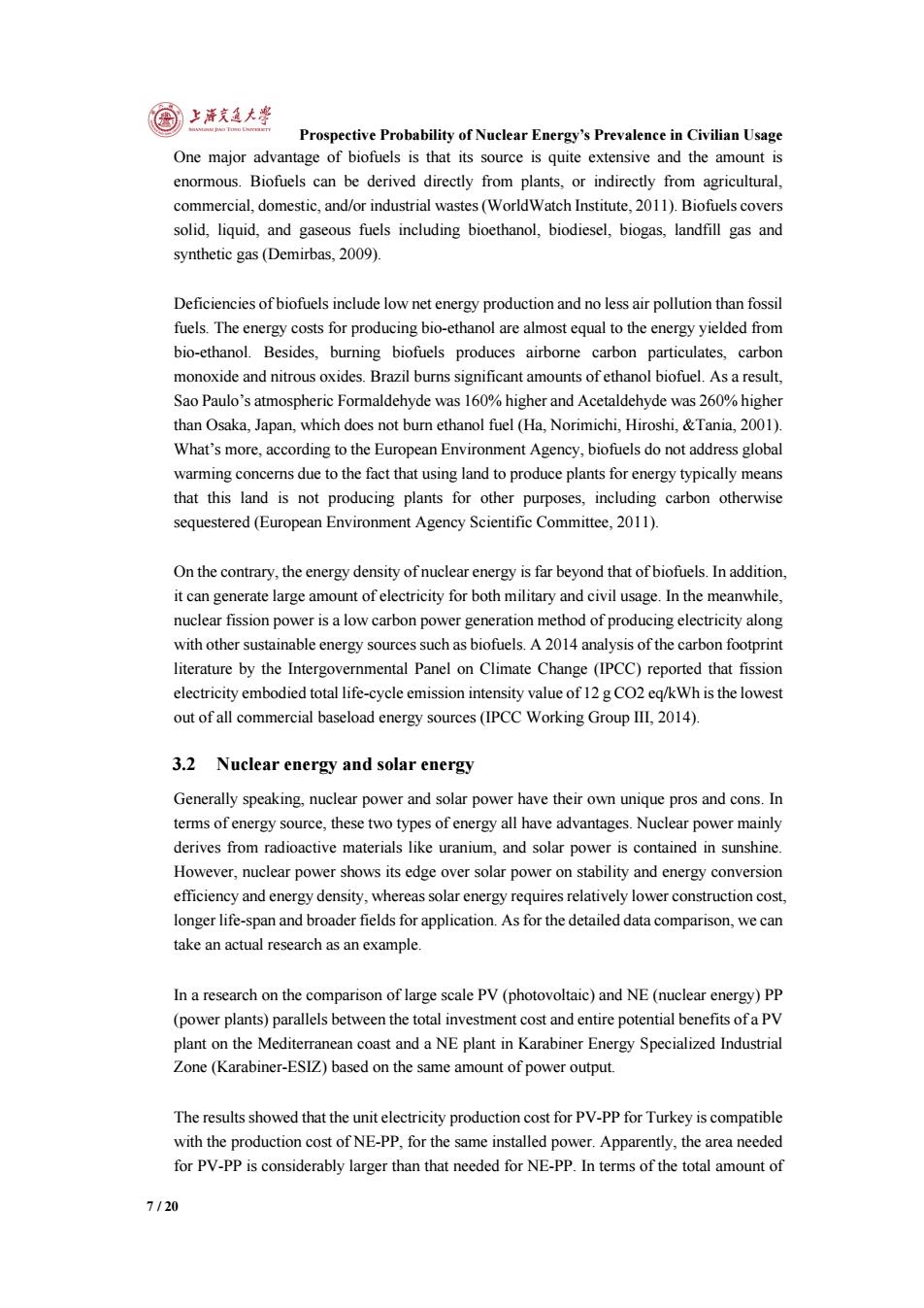
Prospective Probability of Nuclear Energy's Prevalence in Civilian Usage One major advantage of biofuels is that its source is quite extensive and the amount is enormous.Biofuels can be derived directly from plants,or indirectly from agricultural, commercial,domestic,and/or industrial wastes(WorldWatch Institute,2011).Biofuels covers solid,liquid,and gaseous fuels including bioethanol,biodiesel,biogas,landfill gas and synthetic gas(Demirbas,2009). Deficiencies of biofuels include low net energy production and no less air pollution than fossil fuels.The energy costs for producing bio-ethanol are almost equal to the energy yielded from bio-ethanol.Besides,burning biofuels produces airborne carbon particulates,carbon monoxide and nitrous oxides.Brazil burns significant amounts of ethanol biofuel.As a result. Sao Paulo's atmospheric Formaldehyde was 160%higher and Acetaldehyde was 260%higher than Osaka,Japan,which does not burn ethanol fuel (Ha,Norimichi,Hiroshi,&Tania,2001). What's more,according to the European Environment Agency,biofuels do not address global warming concerns due to the fact that using land to produce plants for energy typically means that this land is not producing plants for other purposes,including carbon otherwise sequestered(European Environment Agency Scientific Committee,2011). On the contrary,the energy density of nuclear energy is far beyond that of biofuels.In addition, it can generate large amount of electricity for both military and civil usage.In the meanwhile, nuclear fission power is a low carbon power generation method of producing electricity along with other sustainable energy sources such as biofuels.A 2014 analysis of the carbon footprint literature by the Intergovernmental Panel on Climate Change (IPCC)reported that fission electricity embodied total life-cycle emission intensity value of 12 g CO2 eq/kWh is the lowest out of all commercial baseload energy sources (IPCC Working Group III,2014). 3.2 Nuclear energy and solar energy Generally speaking,nuclear power and solar power have their own unique pros and cons.In terms of energy source,these two types of energy all have advantages.Nuclear power mainly derives from radioactive materials like uranium,and solar power is contained in sunshine. However,nuclear power shows its edge over solar power on stability and energy conversion efficiency and energy density,whereas solar energy requires relatively lower construction cost, longer life-span and broader fields for application.As for the detailed data comparison,we can take an actual research as an example. In a research on the comparison of large scale PV(photovoltaic)and NE(nuclear energy)PP (power plants)parallels between the total investment cost and entire potential benefits ofa PV plant on the Mediterranean coast and a NE plant in Karabiner Energy Specialized Industrial Zone (Karabiner-ESIZ)based on the same amount of power output. The results showed that the unit electricity production cost for PV-PP for Turkey is compatible with the production cost of NE-PP,for the same installed power.Apparently,the area needed for PV-PP is considerably larger than that needed for NE-PP.In terms of the total amount of 7/20
Prospective Probability of Nuclear Energy’s Prevalence in Civilian Usage 7 / 20 One major advantage of biofuels is that its source is quite extensive and the amount is enormous. Biofuels can be derived directly from plants, or indirectly from agricultural, commercial, domestic, and/or industrial wastes (WorldWatch Institute, 2011). Biofuels covers solid, liquid, and gaseous fuels including bioethanol, biodiesel, biogas, landfill gas and synthetic gas (Demirbas, 2009). Deficiencies of biofuels include low net energy production and no less air pollution than fossil fuels. The energy costs for producing bio-ethanol are almost equal to the energy yielded from bio-ethanol. Besides, burning biofuels produces airborne carbon particulates, carbon monoxide and nitrous oxides. Brazil burns significant amounts of ethanol biofuel. As a result, Sao Paulo’s atmospheric Formaldehyde was 160% higher and Acetaldehyde was 260% higher than Osaka, Japan, which does not burn ethanol fuel (Ha, Norimichi, Hiroshi, &Tania, 2001). What’s more, according to the European Environment Agency, biofuels do not address global warming concerns due to the fact that using land to produce plants for energy typically means that this land is not producing plants for other purposes, including carbon otherwise sequestered (European Environment Agency Scientific Committee, 2011). On the contrary, the energy density of nuclear energy is far beyond that of biofuels. In addition, it can generate large amount of electricity for both military and civil usage. In the meanwhile, nuclear fission power is a low carbon power generation method of producing electricity along with other sustainable energy sources such as biofuels. A 2014 analysis of the carbon footprint literature by the Intergovernmental Panel on Climate Change (IPCC) reported that fission electricity embodied total life-cycle emission intensity value of 12 g CO2 eq/kWh is the lowest out of all commercial baseload energy sources (IPCC Working Group III, 2014). 3.2 Nuclear energy and solar energy Generally speaking, nuclear power and solar power have their own unique pros and cons. In terms of energy source, these two types of energy all have advantages. Nuclear power mainly derives from radioactive materials like uranium, and solar power is contained in sunshine. However, nuclear power shows its edge over solar power on stability and energy conversion efficiency and energy density, whereas solar energy requires relatively lower construction cost, longer life-span and broader fields for application. As for the detailed data comparison, we can take an actual research as an example. In a research on the comparison of large scale PV (photovoltaic) and NE (nuclear energy) PP (power plants) parallels between the total investment cost and entire potential benefits of a PV plant on the Mediterranean coast and a NE plant in Karabiner Energy Specialized Industrial Zone (Karabiner-ESIZ) based on the same amount of power output. The results showed that the unit electricity production cost for PV-PP for Turkey is compatible with the production cost of NE-PP, for the same installed power. Apparently, the area needed for PV-PP is considerably larger than that needed for NE-PP. In terms of the total amount of
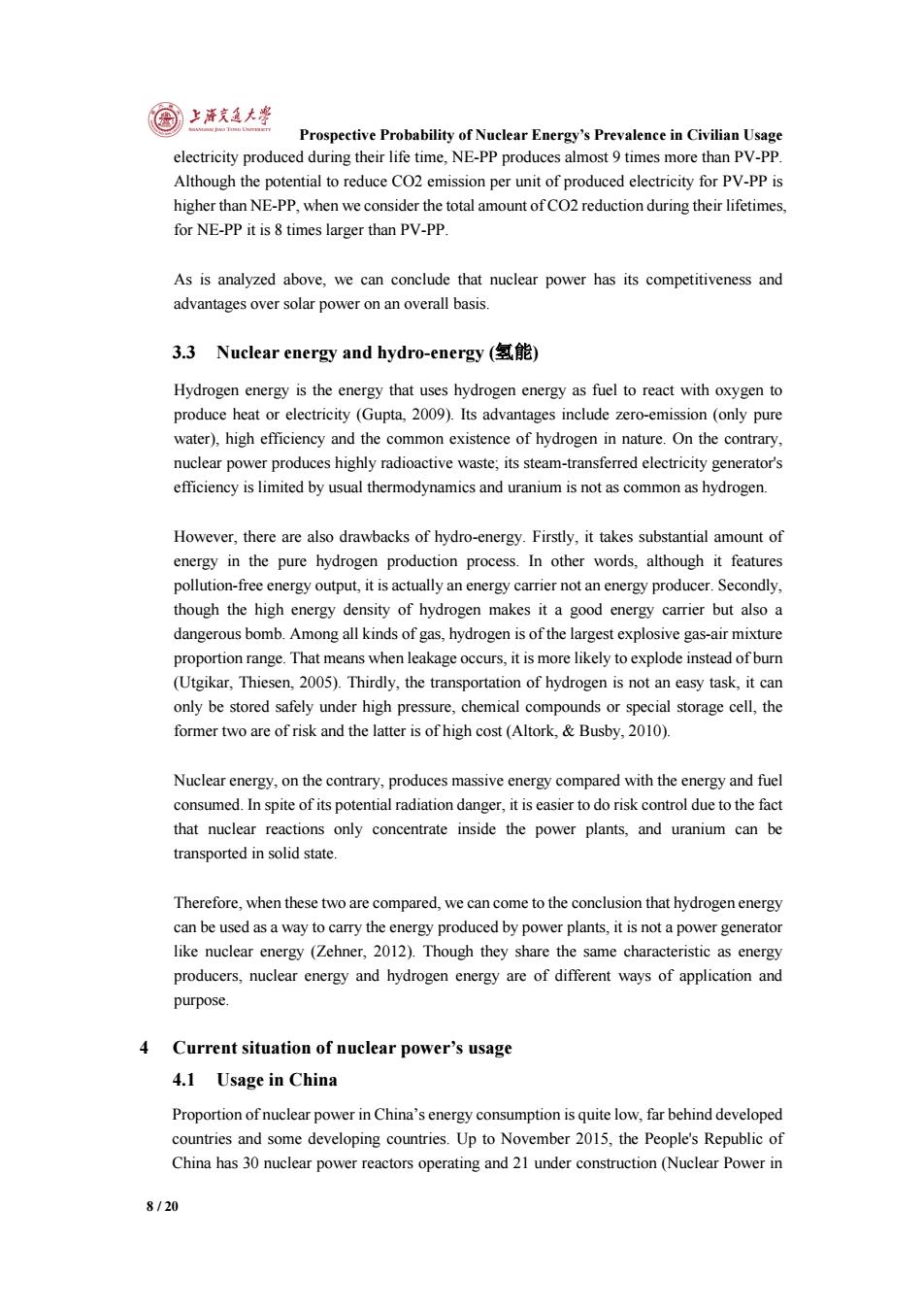
©上洋克道大率 Prospective Probability of Nuclear Energy's Prevalence in Civilian Usage electricity produced during their life time,NE-PP produces almost 9 times more than PV-PP Although the potential to reduce CO2 emission per unit of produced electricity for PV-PP is higher than NE-PP,when we consider the total amount of CO2 reduction during their lifetimes, for NE-PP it is 8 times larger than PV-PP. As is analyzed above,we can conclude that nuclear power has its competitiveness and advantages over solar power on an overall basis. 3.3 Nuclear energy and hydro-energy(氢能) Hydrogen energy is the energy that uses hydrogen energy as fuel to react with oxygen to produce heat or electricity (Gupta,2009).Its advantages include zero-emission (only pure water),high efficiency and the common existence of hydrogen in nature.On the contrary, nuclear power produces highly radioactive waste;its steam-transferred electricity generator's efficiency is limited by usual thermodynamics and uranium is not as common as hydrogen. However,there are also drawbacks of hydro-energy.Firstly,it takes substantial amount of energy in the pure hydrogen production process.In other words,although it features pollution-free energy output,it is actually an energy carrier not an energy producer.Secondly, though the high energy density of hydrogen makes it a good energy carrier but also a dangerous bomb.Among all kinds of gas,hydrogen is of the largest explosive gas-air mixture proportion range.That means when leakage occurs,it is more likely to explode instead of burn (Utgikar,Thiesen,2005).Thirdly,the transportation of hydrogen is not an easy task,it can only be stored safely under high pressure,chemical compounds or special storage cell,the former two are of risk and the latter is of high cost(Altork,Busby,2010). Nuclear energy,on the contrary,produces massive energy compared with the energy and fuel consumed.In spite of its potential radiation danger,it is easier to do risk control due to the fact that nuclear reactions only concentrate inside the power plants,and uranium can be transported in solid state. Therefore,when these two are compared,we can come to the conclusion that hydrogen energy can be used as a way to carry the energy produced by power plants,it is not a power generator like nuclear energy (Zehner,2012).Though they share the same characteristic as energy producers,nuclear energy and hydrogen energy are of different ways of application and purpose. 4 Current situation of nuclear power's usage 4.1 Usage in China Proportion of nuclear power in China's energy consumption is quite low,far behind developed countries and some developing countries.Up to November 2015,the People's Republic of China has 30 nuclear power reactors operating and 21 under construction(Nuclear Power in 8/20
Prospective Probability of Nuclear Energy’s Prevalence in Civilian Usage 8 / 20 electricity produced during their life time, NE-PP produces almost 9 times more than PV-PP. Although the potential to reduce CO2 emission per unit of produced electricity for PV-PP is higher than NE-PP, when we consider the total amount of CO2 reduction during their lifetimes, for NE-PP it is 8 times larger than PV-PP. As is analyzed above, we can conclude that nuclear power has its competitiveness and advantages over solar power on an overall basis. 3.3 Nuclear energy and hydro-energy (氢能) Hydrogen energy is the energy that uses hydrogen energy as fuel to react with oxygen to produce heat or electricity (Gupta, 2009). Its advantages include zero-emission (only pure water), high efficiency and the common existence of hydrogen in nature. On the contrary, nuclear power produces highly radioactive waste; its steam-transferred electricity generator's efficiency is limited by usual thermodynamics and uranium is not as common as hydrogen. However, there are also drawbacks of hydro-energy. Firstly, it takes substantial amount of energy in the pure hydrogen production process. In other words, although it features pollution-free energy output, it is actually an energy carrier not an energy producer. Secondly, though the high energy density of hydrogen makes it a good energy carrier but also a dangerous bomb. Among all kinds of gas, hydrogen is of the largest explosive gas-air mixture proportion range. That means when leakage occurs, it is more likely to explode instead of burn (Utgikar, Thiesen, 2005). Thirdly, the transportation of hydrogen is not an easy task, it can only be stored safely under high pressure, chemical compounds or special storage cell, the former two are of risk and the latter is of high cost (Altork, & Busby, 2010). Nuclear energy, on the contrary, produces massive energy compared with the energy and fuel consumed. In spite of its potential radiation danger, it is easier to do risk control due to the fact that nuclear reactions only concentrate inside the power plants, and uranium can be transported in solid state. Therefore, when these two are compared, we can come to the conclusion that hydrogen energy can be used as a way to carry the energy produced by power plants, it is not a power generator like nuclear energy (Zehner, 2012). Though they share the same characteristic as energy producers, nuclear energy and hydrogen energy are of different ways of application and purpose. 4 Current situation of nuclear power’s usage 4.1 Usage in China Proportion of nuclear power in China’s energy consumption is quite low, far behind developed countries and some developing countries. Up to November 2015, the People's Republic of China has 30 nuclear power reactors operating and 21 under construction (Nuclear Power in
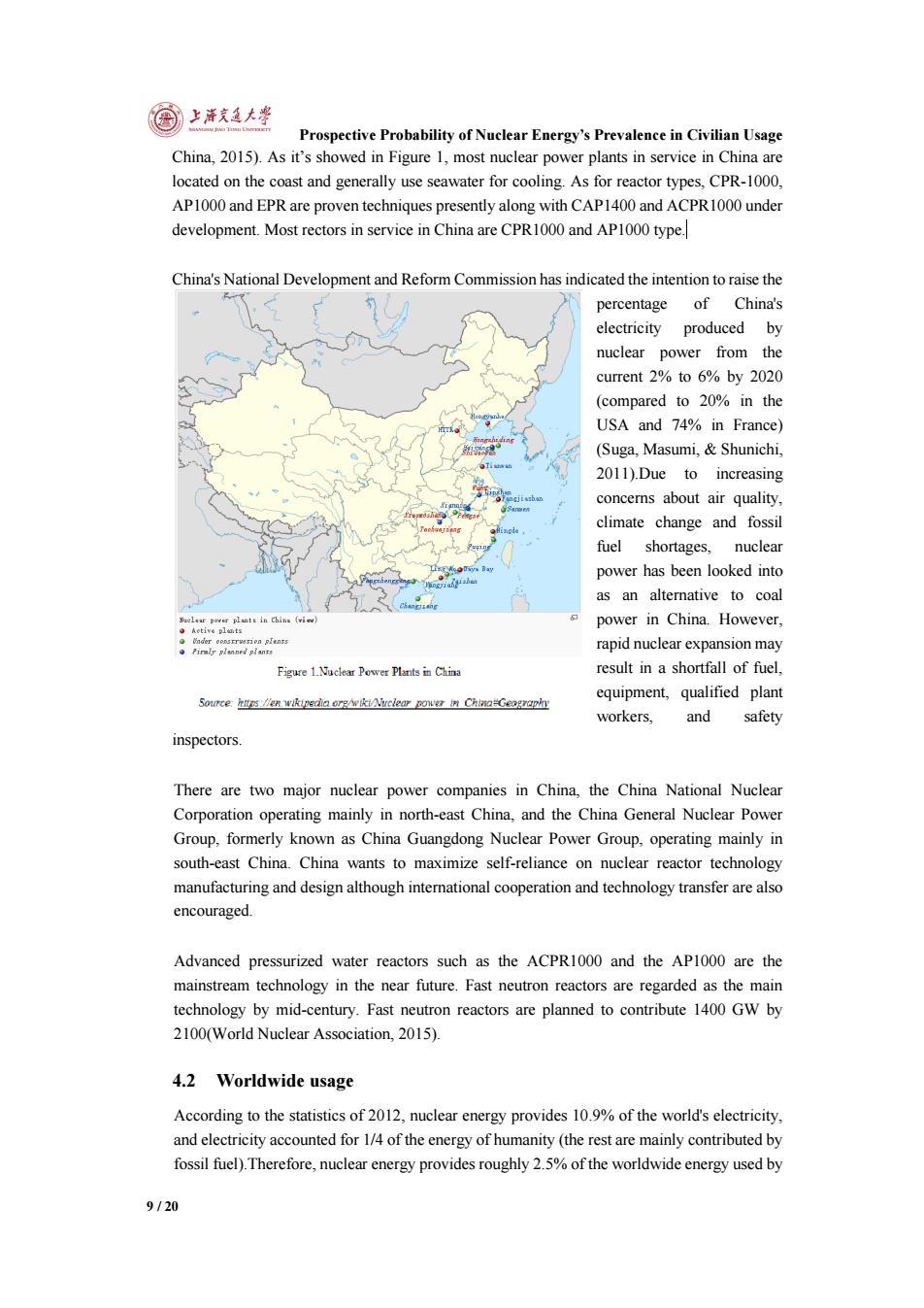
Prospective Probability of Nuclear Energy's Prevalence in Civilian Usage China,2015).As it's showed in Figure 1,most nuclear power plants in service in China are located on the coast and generally use seawater for cooling.As for reactor types,CPR-1000, AP1000 and EPR are proven techniques presently along with CAP1400 and ACPR1000 under development.Most rectors in service in China are CPR1000 and AP1000 type. China's National Development and Reform Commission has indicated the intention to raise the percentage of China's electricity produced by nuclear power from the current 2%to 6%by 2020 (compared to 20%in the USA and 74%in France) (Suga,Masumi,Shunichi, 2011).Due to increasing concerns about air quality, climate change and fossil fuel shortages, nuclear power has been looked into as an alternative to coal power in China.However, ve plo rapid nuclear expansion may Figure 1.Nuclear Power Plants in China result in a shortfall of fuel, equipment,qualified plant Source:https/en.wikipedia org/wikiNuclear power in ChinaGeography workers, and safety inspectors. There are two major nuclear power companies in China,the China National Nuclear Corporation operating mainly in north-east China,and the China General Nuclear Power Group,formerly known as China Guangdong Nuclear Power Group,operating mainly in south-east China.China wants to maximize self-reliance on nuclear reactor technology manufacturing and design although international cooperation and technology transfer are also encouraged. Advanced pressurized water reactors such as the ACPR1000 and the AP1000 are the mainstream technology in the near future.Fast neutron reactors are regarded as the main technology by mid-century.Fast neutron reactors are planned to contribute 1400 GW by 2100(World Nuclear Association,2015). 4.2 Worldwide usage According to the statistics of 2012,nuclear energy provides 10.9%of the world's electricity, and electricity accounted for 1/4 of the energy of humanity(the rest are mainly contributed by fossil fuel).Therefore,nuclear energy provides roughly 2.5%of the worldwide energy used by 9/20
Prospective Probability of Nuclear Energy’s Prevalence in Civilian Usage 9 / 20 China, 2015). As it’s showed in Figure 1, most nuclear power plants in service in China are located on the coast and generally use seawater for cooling. As for reactor types, CPR-1000, AP1000 and EPR are proven techniques presently along with CAP1400 and ACPR1000 under development. Most rectors in service in China are CPR1000 and AP1000 type. China's National Development and Reform Commission has indicated the intention to raise the percentage of China's electricity produced by nuclear power from the current 2% to 6% by 2020 (compared to 20% in the USA and 74% in France) (Suga, Masumi, & Shunichi, 2011).Due to increasing concerns about air quality, climate change and fossil fuel shortages, nuclear power has been looked into as an alternative to coal power in China. However, rapid nuclear expansion may result in a shortfall of fuel, equipment, qualified plant workers, and safety inspectors. There are two major nuclear power companies in China, the China National Nuclear Corporation operating mainly in north-east China, and the China General Nuclear Power Group, formerly known as China Guangdong Nuclear Power Group, operating mainly in south-east China. China wants to maximize self-reliance on nuclear reactor technology manufacturing and design although international cooperation and technology transfer are also encouraged. Advanced pressurized water reactors such as the ACPR1000 and the AP1000 are the mainstream technology in the near future. Fast neutron reactors are regarded as the main technology by mid-century. Fast neutron reactors are planned to contribute 1400 GW by 2100(World Nuclear Association, 2015). 4.2 Worldwide usage According to the statistics of 2012, nuclear energy provides 10.9% of the world's electricity, and electricity accounted for 1/4 of the energy of humanity (the rest are mainly contributed by fossil fuel).Therefore, nuclear energy provides roughly 2.5% of the worldwide energy used by
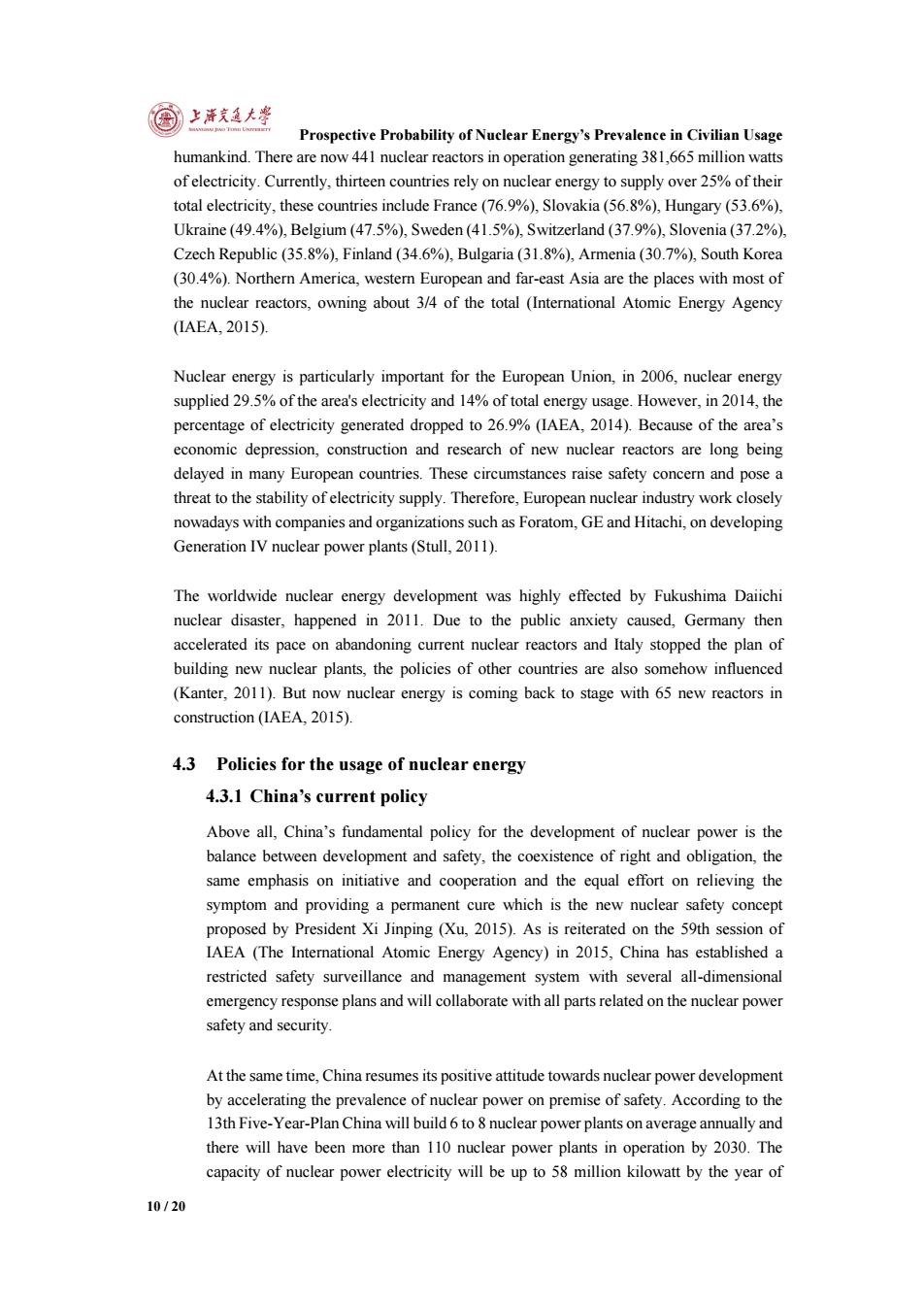
上亥盈大粤 Prospective Probability of Nuclear Energy's Prevalence in Civilian Usage humankind.There are now 441 nuclear reactors in operation generating 381,665 million watts of electricity.Currently,thirteen countries rely on nuclear energy to supply over 25%of their total electricity,these countries include France (76.9%),Slovakia(56.8%),Hungary(53.6%), Ukraine(49.4%),Belgium(47.5%),Sweden(41.5%),Switzerland (37.9%),Slovenia(37.2%), Czech Republic (35.8%),Finland(34.6%),Bulgaria (31.8%),Armenia(30.7%),South Korea (30.4%).Northern America,western European and far-east Asia are the places with most of the nuclear reactors,owning about 3/4 of the total(International Atomic Energy Agency (LAEA,2015). Nuclear energy is particularly important for the European Union,in 2006,nuclear energy supplied 29.5%of the area's electricity and 14%of total energy usage.However,in 2014,the percentage of electricity generated dropped to 26.9%(IAEA,2014).Because of the area's economic depression,construction and research of new nuclear reactors are long being delayed in many European countries.These circumstances raise safety concern and pose a threat to the stability of electricity supply.Therefore,European nuclear industry work closely nowadays with companies and organizations such as Foratom,GE and Hitachi,on developing Generation IV nuclear power plants(Stull,2011). The worldwide nuclear energy development was highly effected by Fukushima Daiichi nuclear disaster,happened in 2011.Due to the public anxiety caused,Germany then accelerated its pace on abandoning current nuclear reactors and Italy stopped the plan of building new nuclear plants,the policies of other countries are also somehow influenced (Kanter,2011).But now nuclear energy is coming back to stage with 65 new reactors in construction(IAEA.2015). 4.3 Policies for the usage of nuclear energy 4.3.1 China's current policy Above all,China's fundamental policy for the development of nuclear power is the balance between development and safety,the coexistence of right and obligation,the same emphasis on initiative and cooperation and the equal effort on relieving the symptom and providing a permanent cure which is the new nuclear safety concept proposed by President Xi Jinping (Xu,2015).As is reiterated on the 59th session of IAEA (The International Atomic Energy Agency)in 2015,China has established a restricted safety surveillance and management system with several all-dimensional emergency response plans and will collaborate with all parts related on the nuclear power safety and security. At the same time,China resumes its positive attitude towards nuclear power development by accelerating the prevalence of nuclear power on premise of safety.According to the 13th Five-Year-Plan China will build 6 to 8 nuclear power plants on average annually and there will have been more than 110 nuclear power plants in operation by 2030.The capacity of nuclear power electricity will be up to 58 million kilowatt by the year of 10/20
Prospective Probability of Nuclear Energy’s Prevalence in Civilian Usage 10 / 20 humankind. There are now 441 nuclear reactors in operation generating 381,665 million watts of electricity. Currently, thirteen countries rely on nuclear energy to supply over 25% of their total electricity, these countries include France (76.9%), Slovakia (56.8%), Hungary (53.6%), Ukraine (49.4%), Belgium (47.5%), Sweden (41.5%), Switzerland (37.9%), Slovenia (37.2%), Czech Republic (35.8%), Finland (34.6%), Bulgaria (31.8%), Armenia (30.7%), South Korea (30.4%). Northern America, western European and far-east Asia are the places with most of the nuclear reactors, owning about 3/4 of the total (International Atomic Energy Agency (IAEA, 2015). Nuclear energy is particularly important for the European Union, in 2006, nuclear energy supplied 29.5% of the area's electricity and 14% of total energy usage. However, in 2014, the percentage of electricity generated dropped to 26.9% (IAEA, 2014). Because of the area’s economic depression, construction and research of new nuclear reactors are long being delayed in many European countries. These circumstances raise safety concern and pose a threat to the stability of electricity supply. Therefore, European nuclear industry work closely nowadays with companies and organizations such as Foratom, GE and Hitachi, on developing Generation IV nuclear power plants (Stull, 2011). The worldwide nuclear energy development was highly effected by Fukushima Daiichi nuclear disaster, happened in 2011. Due to the public anxiety caused, Germany then accelerated its pace on abandoning current nuclear reactors and Italy stopped the plan of building new nuclear plants, the policies of other countries are also somehow influenced (Kanter, 2011). But now nuclear energy is coming back to stage with 65 new reactors in construction (IAEA, 2015). 4.3 Policies for the usage of nuclear energy 4.3.1 China’s current policy Above all, China’s fundamental policy for the development of nuclear power is the balance between development and safety, the coexistence of right and obligation, the same emphasis on initiative and cooperation and the equal effort on relieving the symptom and providing a permanent cure which is the new nuclear safety concept proposed by President Xi Jinping (Xu, 2015). As is reiterated on the 59th session of IAEA (The International Atomic Energy Agency) in 2015, China has established a restricted safety surveillance and management system with several all-dimensional emergency response plans and will collaborate with all parts related on the nuclear power safety and security. At the same time, China resumes its positive attitude towards nuclear power development by accelerating the prevalence of nuclear power on premise of safety. According to the 13th Five-Year-Plan China will build 6 to 8 nuclear power plants on average annually and there will have been more than 110 nuclear power plants in operation by 2030. The capacity of nuclear power electricity will be up to 58 million kilowatt by the year of